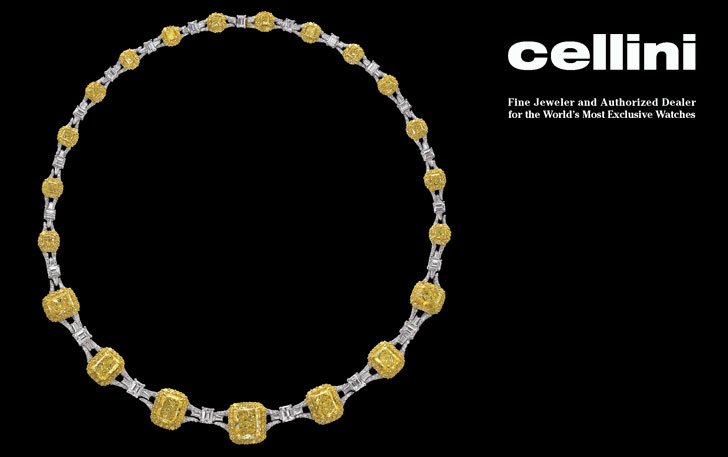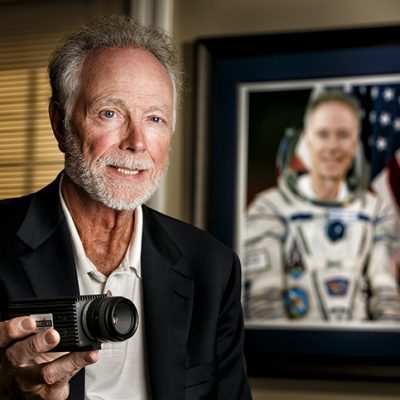
From humble beginnings, a successful scientist, engineer, entrepreneur, and philanthropist has soared to rare heights
by Laura D.C. Kol noski • Photos By amessé photography
Dr. Gregory Olsen’s pursuits are diverse, rooted in the earth and extending past its atmosphere. The owner of a Montana ranch and a South African winery, he was the third civilian to rocket to the International Space Station on a self-funded trip, where he orbited the Earth for ten days in 2006. It’s been quite a journey for the Brooklyn native, who graduated from New Jersey’s Ridgefield Park High School in 1962 with a less than stellar record.
“I was always in trouble and detention,” Dr. Olsen said between meetings, and prior to jetting to Spain in late August. He even missed his junior prom due to a suspension for a minor infraction the same day. With poor grades and after a bout with the juvenile justice system for stealing hubcaps, he considered joining the U.S. Army, until his electrician father counseled him to try college. Growing up, Olsen trailed his dad and tinkered with his tools, unknowingly planting seeds for his own future. Watching the Soviet Union’s Sputnik satellite orbit Earth in 1957 was another early influence.
Apprenticing as an electrician during summers to pay for his education, Olsen elevated his grade point average, graduating magna cum laude from Fairleigh Dickinson University’s Teaneck campus with degrees in physics and electrical engineering. He later earned a PhD in materials science from the University of Virginia. After working at RCA Laboratories, he founded his first company, EPITAXX Inc. in 1984 and sold it in 1990. His second company, Sensors Unlimited, was acquired after nine years by another company. He repurchased it two years later, selling in 2005 to the Goodrich Corporation. Holder of a dozen patents on lasers and infrared light detection, he is now President of GHO Ventures in Princeton. Perusing the newspaper in a Princeton Starbucks one day, he read an article about Space Adventures Ltd., a firm offering space tourism experiences for private citizens.
“I always thought that was something I’d like to do,” Olsen said. “As a teen, I saw a scuba diver coming out of the sea and I thought that was great, while others found it dangerous. I was never scared, or I would not have done it.” Always “reasonably fit” Olsen travelled to Russia, undergoing the same training as professional astronauts. Living in a small Russian village for six months, he had an interpreter during classes (learning the language was the toughest part of that phase). He also shared a dormitory with NASA astronauts, many of whom are still his friends.
Trainees took “zero-G” flights on the so-called “Vomit Comet,” a jet that makes a series of dives to achieve temporary weightlessness. They were also placed in a centrifuge which accelerated to produce eight times the force of Earth’s gravity (simulating launch and landing conditions). Using the radio and fire extinguishers, emergency procedures, drills, and physical conditioning were all parts of the intensive training.
“I adapted quite readily to weightlessness in space and had no problems with motion sickness,” he related, adding he was well-treated by his Russian counterparts. “I loved the feeling of life in space, but it was tricky getting used to everything floating around. If you put a pencil down it would often just come up again. We had to use Velcro or bungee cords.” While in the Station, small particles of space junk would occasionally hit the windows, but it was what was outside of them that made the greatest impact.
“From space, Earth looks like a big blue sphere with no obvious signs of life for the 45 minutes of daylight during our 90-minute orbit,” he said. “Since we were only 240 miles above the Earth, stars and planets look the same, only much brighter because there is no atmosphere to distort the light. In the night, I could see lights on the planet. I felt like the luckiest person alive to have that experience.” The only glitch, he said, occurred during his first training period when the Russians were quick to disqualify him for a minor medical issue. It took a year to get back into the program.
While in space, he held ham radio sessions with high school students in Princeton, Ridgefield Park, and Fort Hamilton, Brooklyn, and National Geographic produced an hour-long documentary devoted to his flight.
Back on terra firma, when not working on his businesses, he counsels others in entrepreneurship, especially youth groups. He holds the title of “Entrepreneur in Residence at Princeton University,” working from his office across the street from the famed school. Through his “Angel Investing” efforts, Olsen also seeks out burgeoning ventures in areas he has some understanding of or background in.
“I invest primarily in people; those with high drive, the personality to attract other good people, and the ability to navigate through the rough times every business has,” he said. “Any student or faculty member thinking of starting a business can come to my office. I look for that hunger…that they really want it to happen.”
A love of American history led him to visit General George Armstrong Custer’s Montana battlefield. He fell in love with the area and bought a 3,000-acre ranch there in 2002, which today has both horses and cattle.
A post-doctorate in physics at the University of Port Elizabeth in South Africa in the 1970s led Olsen into the wine business. In 2002, he bought a winery that now makes 10,000 bottles per year of several varietals (including Chenin Blanc and Pinotage) sold through his website. He travels there every February during harvest time among the slopes of the Klein Drakenstein Mountains in Paarl, a premium South African winegrowing region. He enjoys winemaking because, as he put it, “It’s creative and so much fun. You just have to start with good grapes and not mess it up.” (The winery grows all the hand-picked grapes used in its production.)
Paying it Forward
Dr. Olsen, who was a Big Brother with Big Brothers/Big Sisters in Trenton and still works with that organization, frequently addresses young people on career opportunities in math, science, and engineering—particularly minorities and women.
“Science was the quick way up for me,” he explained. “Any women with a bachelor’s degree in any science can name her price, because the workplace is still very polarized. I always start out by telling my own story—how I failed high school trigonometry and how I was a screw-up. Kids think, ‘Here’s this rich white guy who probably went to Princeton.’ The message I try to give, whether its to kids or adults, is it doesn’t matter. Don’t give up is the secret. Survive your mistakes.”
In addition to numerous board memberships with a long roster of technological concerns, Olsen is currently a director with Princeton Power Systems, United Silicon Carbide, Power Survey Company, Innovative Photonics, and MLT Drive in South Africa. These groups are involved in such diverse pursuits as energy storage systems, stray voltage detection in city streets, laser systems, and solar inverters. He has also lectured on energy and the environment at Rider University in Lawrenceville.
The former Space Station occupant has two grown daughters, Krista who lives in Colts Neck and Kim who resides in Spain, and six grandchildren. Krista Olsen-Dibsie is a cofounder of The Beauty Foundation, which hosts an annual starstudded gala to assist women suffering from cancer—inspired by her father to give back at a young age, she has stated.
The Final Frontier
Regarding today’s American space program, Olsen hopes for a resurgence and renewed commitment. He has particular affinity for the SpaceX company, which designs, manufactures, and launches advanced rockets and spacecraft, with the ultimate goal of enabling people to live on other planets.
“I’d like to see the government do more,” he said. “We’re in idle mode now, and I don’t see a lot of movement in the near future.” He singled out Elon Musk, the South African-born American business magnate, engineer, inventor, and investor who heads SpaceX and Tesla Motors as, “the next Nicola Tesla.”
“I’m excited about private space travel,” he concluded. “Technologically, we can get to Mars, but can we get back? We can do all the engineering, but it costs a lot of money. I hope we get the vision to do it. I want to see people be futuristic and invest in education and research.”
Would he return to space given the opportunity?
“In a heartbeat,” he declared.
Dr. Gregory Hammond “Greg” Olsen
GHO Ventures / Princeton, New Jersey / ghoventures.com







